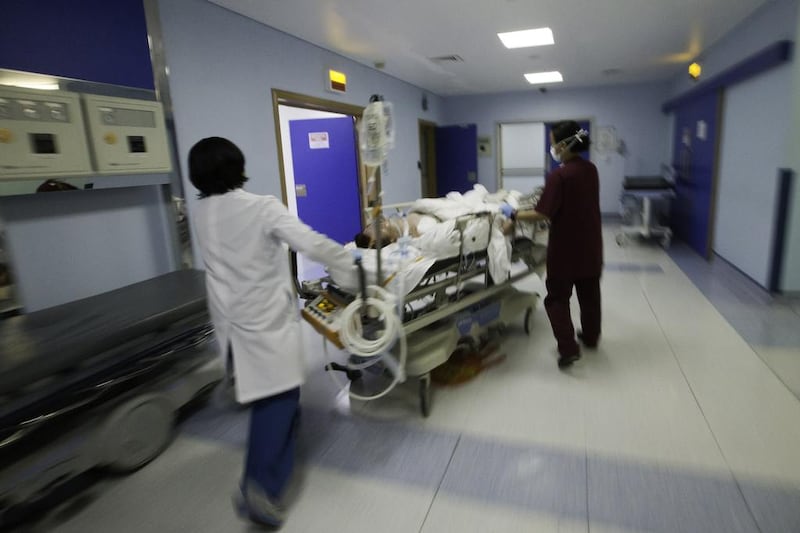DUBAI // An ambulance swerves to a halt as paramedics battle to bring the patient back from the brink of death.
The man is wheeled into a resuscitation room at Rashid Hospital’s trauma centre on a stretcher as a 10-strong team perform CPR on him.
Open 24 hours a day, seven days a week, the trauma centre is dedicated to treating emergency patients in Dubai and the Northern Emirates for all types of illnesses and injuries, such as victims of road traffic accidents, infectious diseases and major disasters.
The hospital's trauma team has allowed The National to spend an afternoon with them to provide a confidential realtime account on the front lines of health care in the UAE to show the daily pressures the team face.
There is a constant hive of activity. There seems to be no let-up in the constant stream of patients who are brought to the centre in Oud Metha.
In a transition area, two patients are receiving initial assessment for seizures.
Staff work to determine the severity of each patient’s condition.
The trauma centre follows a triage system based on five priority levels – triage level one is a life threatening case, such as a heart attack, while triage level five is a non-emergency case.
Last year 166,000 patients were treated at the centre, according to Dr Moin Fikree, the centre’s medical director, with demand almost doubling in the eight years it has been operating.
When it opened in 2006, the centre treated 86,000 patients in that first year. Dr Fikree says that figure will rise in 2014.
“We are always 100 per cent full,” he says.
It means the some 300-plus medical staff at the centre will treat between 480 and 550 patients a day.
“We have our peak times and they start at about 1pm and then carry on until 1am in the morning,” he says. “Those 12 hours are really very busy and we see more than 70 per cent of our patients in those hours.”
Winter months tend to be busier and road traffic accidents are the most common type of injury.
Strokes, heart attacks and accidents on a construction or building site are also common.
This was evident on Monday.
Three men, workers on a building site in Dubai, are brought into the centre suffering from second and third-degree burns after an explosion at their workplace.
One waits in a resuscitation room, while his colleagues are taken to the intensive care unit.
Trauma patients now make up the majority of patients at the centre, says Dr Fikree, rather than medical emergencies.
A medical case would be a seizure or heart attack, while a trauma would be described as a burn victim or a road traffic accident.
“We have now reached a point when most of our services are trauma related and we tend to shift the medical patients to other departments before they come to us.”
By midday, 194 patients have been admitted to the centre.
In one of the waiting rooms a 12-year-old American boy clutches one of his arms as he waits for treatment.
He was brought in following an accident in a school playground.
“I was playing football. Someone kicked a ball into my hand and my hand broke,” he says. “It is my first broken bone.”
In another part of the hospital, a construction worker waits for help after collapsing.
Elsewhere, an elderly lady is brought in by paramedics after suffering with a fever.
An electrician is tended to by a nurse as he awaits the result of an X-ray. He was brought in after falling off a ledge and doctors suspect he has multiple fractures.
A 16-year-old student and army cadet is also awaiting an X-ray on a swollen wrist. He feels dizzy and collapses, hurting an arm and doctors believe he has broken his wrist.
“Nobody sees the level of patients we treat,” says Dr Fikree. “We are the busiest in the region.”
In one of the resuscitation rooms at the trauma centre, the team of doctors and nurses performing CPR on the heart attack patient have to stop their efforts after more than half an hour.
Medics then deliver the news to the anxious family waiting outside that their efforts have been unsuccessful.
One family member slumps to the floor after hearing the news.
This is the hard point for doctors.
“We are all working to save lives at the end of the day,” says Dr Fikree.
“That is what we are here for.”
jbell@thenational.ae





